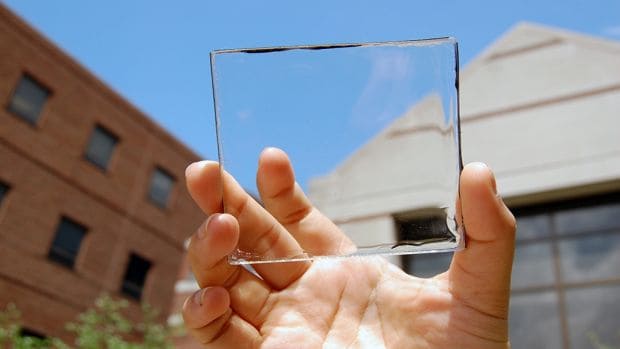Transparent Solar materials which could be applied to windows, buildings, car windows (effectively any device with a clear surface) have been created at Michigan State University. The highly transparent solar cells represent a gigantic step forward for solar technology and we’re excited to see the different types of applications they’ll have when they come to market.
Transparent Solar Materials – Solar Windows and more?

Engineering researchers at Michigan State University released a paper entitled ‘Solar energy that doesn’t block the view‘ in 2014. Since then they’ve been improving the technology efficiency and preparing it for market.
Dr. Richard Lunt, the Johansen Crosby Endowed Associate Professor of Chemical Engineering and Materials Science at MSU, was one of the scientists responsible for this breakthrough. Along with Christopher Traverse, Richa Pandey, and Miles Barr from Ubiquitous Energy Inc, the team have been working towards increasing the efficiency of the transparent solar film. They’re currently recording efficiencies of over 10% (typical solar panels are 15-20% efficient in converting sunlight into energy), so there’s still a ways to go, but considering these are able to be applied while not affecting the usability of windows etc., it’s a major breakthrough.
“Highly transparent solar cells represent the wave of the future for new solar applications,” Dr. Lunt said. “We analyzed their potential and show that by harvesting only invisible light, these devices can provide a similar electricity-generation potential as rooftop solar while providing additional functionality to enhance the efficiency of buildings, automobiles and mobile electronics.”
According to the SMH, the tech works via organic molecules within the transparent film – they absorb ultraviolet and infrared lightwaves (invisible to the human eye) and convert the lightwaves into electricity. The molecules do this by directing the lightwaves to small photovoltaic cells at the edge of the screen. This allows them to allow visible light through and still harness the energy. The film itself is less than one-thousandth of a millimetre thick!
The team estimate there is 5-7 billion square metres of glass in the United States – so if this tech were to be applied at scale it could just about fulfil half of America’s energy needs. Another great step forward for solar panel technology!
You can also read the article entitled “Emergence of highly transparent photovoltaics for distributed applications” on Nature.com by clicking here (requires subscription).
Alternatively, watch the video below which shows a working prototype by Dr. Lunt!

